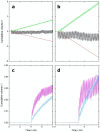Development of in-airway laser absorption spectroscopy for respiratory based measurements of cardiac output
- PMID: 33664377
- PMCID: PMC7970843
- DOI: 10.1038/s41598-021-84649-0
Development of in-airway laser absorption spectroscopy for respiratory based measurements of cardiac output
Abstract
Respiratory approaches to determining cardiac output in humans are securely rooted in mass balance and therefore potentially highly accurate. To address existing limitations in the gas analysis, we developed an in-airway analyser based on laser absorption spectroscopy to provide analyses every 10 ms. The technique for estimating cardiac output requires both a relatively soluble and insoluble tracer gas, and we employed acetylene and methane for these, respectively. A multipass cell was used to provide sufficient measurement sensitivity to enable analysis directly within the main gas stream, thus avoiding errors introduced by sidestream gas analysis. To assess performance, measurements of cardiac output were made during both rest and exercise on five successive days in each of six volunteers. The measurements were extremely repeatable (coefficient of variation ~ 7%). This new measurement technology provides a stable foundation against which the algorithm to calculate cardiac output can be further developed.
Conflict of interest statement
Oxford University Innovation, a wholly owned subsidiary of the University of Oxford, holds/has filed the patents relating to the background IP for the device. J.C., G.H., P.A.R. and G.A.D.R. have an interest in one or more patents. N.M.J.S., G.R. and D.S. have no conflict of interest.
Figures






Similar articles
-
Noninvasive Assessment of Cardiac Output: Accuracy and Precision of the Closed-Circuit Acetylene Rebreathing Technique for Cardiac Output Measurement.J Am Heart Assoc. 2020 Sep;9(17):e015794. doi: 10.1161/JAHA.120.015794. Epub 2020 Aug 27. J Am Heart Assoc. 2020. PMID: 32851906 Free PMC article.
-
Non-invasive measurement of cardiac output: evaluation of new infrared absorption spectrometer.Respir Physiol Neurobiol. 2006 Sep 28;153(2):191-201. doi: 10.1016/j.resp.2005.09.010. Epub 2005 Dec 2. Respir Physiol Neurobiol. 2006. PMID: 16326150 Clinical Trial.
-
A comparison between freon and acetylene rebreathing for measuring cardiac output.Aviat Space Environ Med. 1980 Nov;51(11):1214-21. Aviat Space Environ Med. 1980. PMID: 7213267
-
Is pulmonary gas exchange during exercise in hypoxia impaired with the increase of cardiac output?Appl Physiol Nutr Metab. 2008 Jun;33(3):593-600. doi: 10.1139/H08-010. Appl Physiol Nutr Metab. 2008. PMID: 18461116 Review.
-
The physiology of submaximal exercise: The steady state concept.Respir Physiol Neurobiol. 2017 Dec;246:76-85. doi: 10.1016/j.resp.2017.08.005. Epub 2017 Aug 15. Respir Physiol Neurobiol. 2017. PMID: 28818484 Review.
References
-
- Fick, A. Uber die messung des Blutquantums in den Hertzvent rikeln. Sitzber Physik Med Ges Wurzburg, Vol. 36 (1870).
-
- Grollman A. The determination of the cardiac output of man by the use of acetylene. Am. J. Physiol. 1929;88:432–445. doi: 10.1152/ajplegacy.1929.88.3.432. - DOI
Publication types
MeSH terms
Grants and funding
LinkOut - more resources
Full Text Sources
Other Literature Sources

